Choosing The Right Soft Pastels for Portraits:
Selecting the appropriate soft pastels is vital while working on portraits in order to capture the complex details of human skin tones and produce realistic results. When choosing your pastel set, look for brands that provide a wide variety of flesh tones, such as warm and cool variations, along with delicate colors for highlights and shadows. Seek out sets that are especially designed for portrait artists, like those offered by Stationers.pk, who are aware of the particular requirements of portraits. Colors like peach, rose, reddish, and brown are frequently included in these sets; they are carefully chosen to faithfully represent the variety of skin tones ranging from fair to deep. Additionally, take into account the consistency and texture of the pastels; softer pastels make it simpler to blend and overlay colors to create smooth transitions in your pictures.

Understanding Light and Shadow:
In order to produce very believable portraits, painters need to study light and shadow in great detail. It's not only about seeing the way light hits the face; it's also about understanding the complex relationship between light and form. Observe how the light dances over the face's contours, highlighting certain parts and obscuring others. Examine the minute variations in temperature and tone, from the chilly depths of shadows to the bright glow of highlights. Observe how light reflects off objects and rebounds onto nearby spaces to produce subtle color variations and secondary highlights. Through a thorough examination of these subtleties, painters are able to faithfully portray the three-dimensional qualities of the face, giving their portraits a sense of depth, dimension, and realistic reality.
Sketching the Portrait Initial Outlines and Composition:
Carefully drawing initial designs is a necessary step before starting the complex portrait painting process. Start by closely examining the subject and using a pastel pencil or a soft pastel stick, delicately outline the main features of the face. Make sure to accurately depict the distinct features of the lips, nose, eyes, and jawline, paying close attention to location and proportion. Be especially mindful of the minute details in expression, since the smallest change can change how lifelike the figure appears. Think on the portrait's overall composition while you sketch, taking into account components like the background, the framing, and the negative space. Make an effort to strike a harmonious balance between the subject and the background, making sure that each component enhances the overall impression.
Layering and Blending Techniques for Realistic Skin Tones:
Realistic skin tones can be achieved with soft pastels by carefully balancing technique and observation. To begin, choose a spectrum of colors that approximate the skin tones of the subject: warm tones such as peach and Florence, cool tones such as blue and lavender, and neutral tones such as gray and beige. Using soft, feathery strokes, start painting the foundation layer of color, being careful to keep luminosity by leaving regions of highlight intact. Gradually add darker tones to form curves and shadows as you build layers, being mindful of how light and shadow interact with the skin's surface. Try combining complementary colors in layers to enhance texture and depth, as well as little details that make the image seem more realistic.
To mix colors together smoothly and without creating harsh lines or streaks, apply light pressure and move in circular motions. To create various textures and effects, try utilizing a range of blending tools, like soft brushes, blending stumps, or even your fingertips. Soft pastels are a medium that is easy to work with and forgive, enabling artists to improve their skills and produce skin tones that are realistic and add to the overall reality of their portraits.
Adding Details and Final Touches to Bring Your Portrait to Life:
Adding fine details and polishing the overall look are the last steps in creating a portrait. Concentrate on capturing the distinct qualities of your subject, giving particular attention to features like the lips, eyes, eyebrows, and hair. To give definition and depth to these regions and to create realism, emphasize highlights and shadows with fine-tipped pastel pencils or sticks. Spend some time observing the finer points of wrinkles, skin texture, and facial expressions to make sure your portrait truly captures the uniqueness and character of your subject. Gradually add details and finishing touches to your work until you reach a satisfactory degree of expressiveness and resemblance.
Enhance Your Artistic Journey with Confidence:
When it comes to sourcing the best collection of soft pastels, Stationers.pk stands out as a go-to destination. With a curated selection of top-quality brands and an extensive range of colors, Stationers ensures that artists have access to the finest materials to bring their visions to life. From vibrant landscapes to delicate portraits, the impact of using high-quality soft pastels from Stationers is undeniable, allowing artists to unleash their creativity and produce stunning artworks that leave a lasting impression.
Embracing Creativity with Soft Pastels:
Soft pastels offer artists a dynamic and expressive medium to unleash their creativity and bring their visions to life. Whether you're a beginner or an experienced artist, exploring the techniques and possibilities of soft pastels can lead to exciting discoveries and captivating artwork. By understanding the materials, experimenting with techniques, and embracing the process, artists can unlock the full potential of soft pastels and create stunning masterpieces that inspire and delight viewers.

